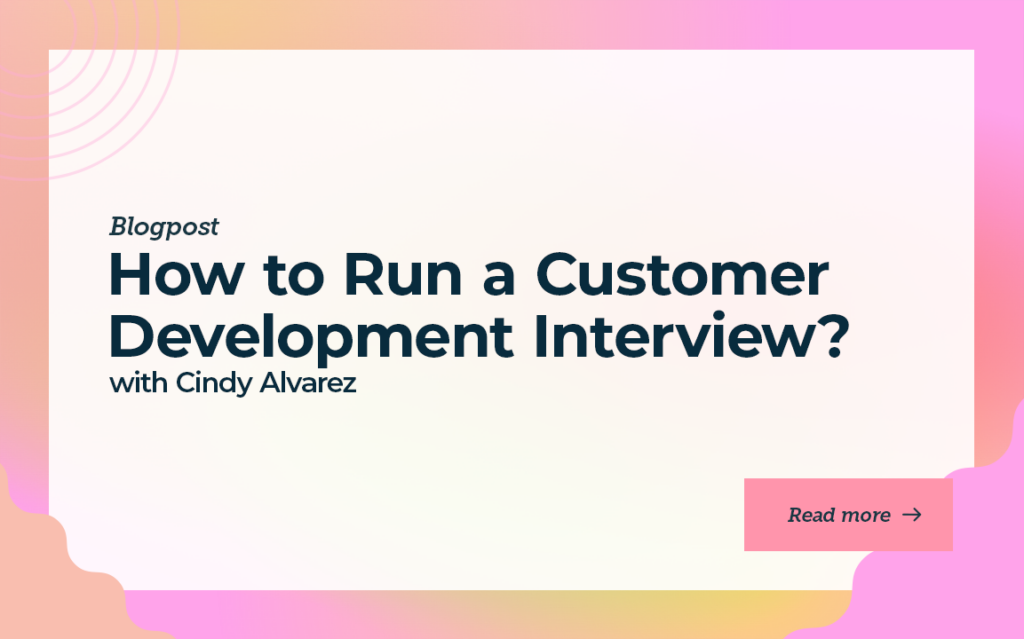How to Run a Customer Development Interview?

Stepping into the world of customer development can be daunting, especially when you’re unsure what to ask or how to approach potential users without a finished product.
However, Cindy Alvarez, author of “Lean Customer Development” and Director of UX for PowerPoint, believes embracing these uncertainties is the key to successful product development.
In this episode, Cindy explains why this initial discomfort is normal and essential for innovation.
The Courage to Ask
Cindy Alvarez highlights a common fear among product developers: the hesitation to conduct customer development interviews without a concrete product. This fear often stems from the anxiety of being perceived as unprepared or lacking expertise.
However, Cindy argues that this mindset can significantly hinder innovation. Through her experience, she has seen that customers are often eager to share their problems and ideas, even if a product doesn’t yet exist.
Overcoming Hesitations in Customer Development
Instead of focusing on presenting a polished product, Cindy encourages developers to embrace the process of asking questions and listening. This approach helps gather valuable insights and builds a stronger connection with potential users who appreciate being part of the development process.
One of Cindy’s key points is that humans are naturally inclined to talk about their problems. By framing the conversation around these issues rather than the product itself, developers can unlock a wealth of information that guides the product’s evolution.
It’s a simple yet profound shift in mindset that can turn initial discomfort into a powerful tool for creating products that truly resonate with users.
Understanding Customer Motivation
The essence of customer development lies in understanding what customers say and what they truly mean.
Cindy highlights how customers often express their frustrations in ways that don’t directly align with their problems. For example, users might say they want a specific feature but need a solution to a deeper issue they’re struggling with.
Collin’s approach to sales, influenced by Cindy’s methodology, demonstrates this principle in action. By shifting from a “salesperson” mindset to that of a “solution therapist,” he emphasizes the importance of diagnosing the customer’s actual pain points.
This change leads to more meaningful conversations, where the goal isn’t just to sell but to understand and address the customer’s underlying needs. This strategy doesn’t just close deals; it builds trust and long-term relationships.
A Deeper Dive into Customer Development
In sales and product development, the real breakthrough comes when you stop trying to confirm your ideas and genuinely explore the customer’s world. Cindy encourages starting interviews with a learning mindset, asking open-ended questions without assuming you know the answers.
This approach uncovers customers’ needs and opens innovation and product development avenues.
Collin’s experience reinforces that when customers feel heard, they’re more likely to engage deeply, often revealing insights that wouldn’t emerge in a traditional sales conversation. He found that when he approached customer development interviews with humility and genuine curiosity, customers were more than willing to share their experiences and challenges.

Navigating the Problem Space with Precision
When starting customer development, exploring the problem space thoroughly before considering any solutions is vital.
Cindy emphasizes the importance of asking open-ended questions such as, “What frustrates you about this?.” This approach uncovers the pain points and provides insights to guide your product development.
At Yammer, this strategy was pivotal. Rather than pushing a solution, Cindy and her team focused on understanding users’ communication challenges. “It’s not about validating your idea; it’s about truly grasping the user’s problem,” Cindy notes, highlighting the shift from a solution-oriented mindset to one that prioritizes user experience.
To effectively navigate the problem space, consider these steps:
- Start Broad: Ask open-ended questions to understand the user’s experience without leading them toward a specific solution.
- Listen for Emotion: Pay attention to the passion or frustration in their responses, which can indicate significant pain points.
- Iterate Based on Feedback: Use the insights gathered to refine your understanding before narrowing down on potential solutions.
By allowing users to express their frustrations and needs, you can discover that the most valuable opportunities often lie in areas initially overlooked. This method ensures that actual user demands, not assumptions, guide your product development.
Structuring Successful Customer Interviews
You need a blend of strategic questioning and active listening to run compelling customer development interviews.
Here’s a refined approach:
- Open-Ended Questions: Start with broad questions that allow the interviewee to share in-depth responses. For example, “Tell me how you manage [specific task].” This can reveal hidden challenges or needs that aren’t immediately obvious.
- Active Listening and Pauses: Resist jumping to the next question after your initial question. Pausing gives the interviewee time to think and often leads them to offer more detailed insights. Use phrases like “Tell me more” to encourage further elaboration.
- Handling Confirmation Bias: Cindy suggests categorizing responses into three buckets: confirmations, contradictions, and surprises. While often overlooked, “surprise” responses can significantly influence your product’s direction months later.
- Starting with Friendly Interviews: Begin your research with low-pressure, friendly interviews. This approach helps you refine your questioning technique and gain confidence. It also sets a positive tone for more formal interviews later.
- Magic Wand Question: Towards the end, ask a “magic wand” question: “If you could wave a magic wand and solve this problem instantly, what would you do?” The answers to these seemingly unrealistic questions can often contain the seed of a breakthrough idea.
Note: The "magic wand" question is powerful because it captures your customer's values. It reveals whether the feature would significantly impact their day-to-day operations or offer marginal improvements.Mastering Customer Conversations
Cindy advocates for probing deeper, particularly when customers request specific features. When a customer asks for a feature, your goal should be understanding the underlying motivation.
Ask questions like, “If you had this feature today, what would it allow you to do?” This approach can help reveal whether the request is driven by a genuine business need or simply the desire to match a competitor.
Not all requests are created equal.
Some customers might ask for features based on perceived value rather than actual utility. By digging deeper, you can uncover whether the request would lead to significant business benefits, like saving time or enabling new capabilities, or if it’s more about providing reassurance or reducing anxiety.
- Probe for Real Impact: Instead of taking feature requests at face value, dig into the potential outcomes. Ask how the feature would change their workflow or decision-making process.
- Understand Emotional Drivers: Sometimes, a feature’s value makes users feel more competent, less stressed, or more in control.
- Assess Situational Value: Consider the context in which the feature would be used. A feature that seems trivial in one scenario might be critical in another.
This method ensures that your product development is guided by genuine needs rather than superficial demands, leading to more meaningful innovation and customer satisfaction.

Identifying True Value
One of the most insightful aspects of customer development is distinguishing between a genuine need and a mere feature request.
Cindy highlighted the importance of probing deeper when customers ask for new features. She pointed out that customers often ask for a feature simply because they’ve heard it’s available elsewhere or because it seems nice.
However, the real value comes from understanding what customers hope to achieve with that feature.
Beyond the Feature Request
A critical question is, “If you had this feature today, what would it allow you to do?” This not only helps uncover the actual problem the customer is trying to solve but also reveals whether the feature would genuinely enhance their workflow or if it’s simply an attempt to keep up with competitors.
Businesses can prioritize developments that deliver real impact by focusing on underlying motivations.
Key considerations when evaluating feature requests:
What’s the end goal?
- Understand what the customer aims to achieve.
Is it a must-have or nice-to-have?
- Determine the necessity versus the desire.
How does it impact their work?
- Evaluate the potential improvement in efficiency or effectiveness.
When to Consider Monetization in Customer Development
As startups move from ideation to product development, a common challenge is determining the right time to shift focus from understanding problems to considering, for example, website monetization.
Cindy suggests a counterintuitive approach: don’t immediately think of your interviewees as potential customers. The initial goal should be to gather insights that will help refine the product for a broader market, not to secure early sales.
She emphasized that if an interviewee is genuinely interested in becoming a customer, they will make it known. Indicators like unsolicited follow-ups, requests to join pilots, or beta programs are strong signals of potential early adopters.
Yet, it’s crucial to view the first few interviewees as expendable. What you learn from them will be invaluable for reaching a much larger audience later.
Conclusion
Reflecting on the evolution of customer development practices, Cindy notes that human behavior remains consistent despite technological advances and changing business landscapes. Whether it’s handling feature requests or conducting interviews, the core challenges and best practices outlined in her decade-old book are as relevant today as they were then.
“The world changes, but humans never change,” Cindy concludes, highlighting that while tools and platforms evolve, the fundamental aspects of understanding customer needs and motivations endure.
Check out Cindy Alvarez’s insights on turning uncertainty into innovation. Discover how to connect with your customers today!
Unlock the secrets to mastering customer development. Listen now to see how real growth happens.
NO TIME TO READ?
Listen On:


